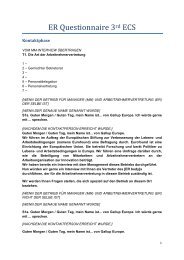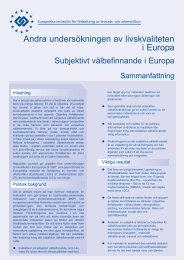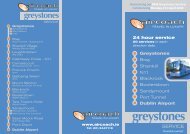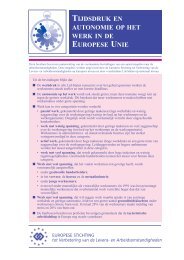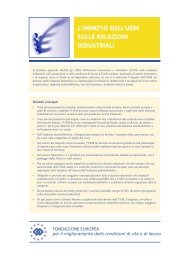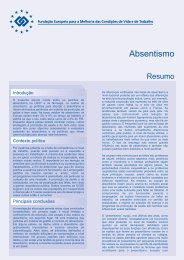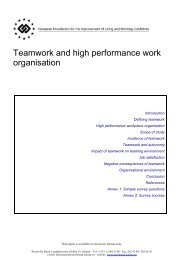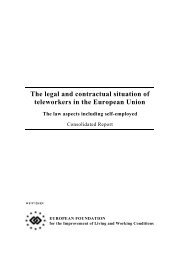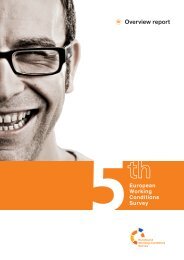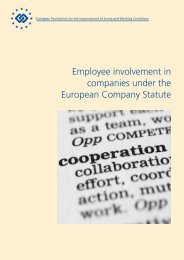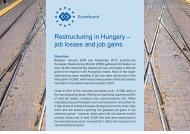The automotive cluster in Baden-Württemberg, Germany
The automotive cluster in Baden-Württemberg, Germany
The automotive cluster in Baden-Württemberg, Germany
Create successful ePaper yourself
Turn your PDF publications into a flip-book with our unique Google optimized e-Paper software.
European Foundation for the Improvement of Liv<strong>in</strong>g and Work<strong>in</strong>g Conditions<br />
<strong>The</strong> <strong>automotive</strong> <strong>cluster</strong> <strong>in</strong><br />
<strong>Baden</strong>-<strong>Württemberg</strong>, <strong>Germany</strong><br />
This report is available <strong>in</strong> electronic format only<br />
Wyattville Road, Loughl<strong>in</strong>stown, Dubl<strong>in</strong> 18, Ireland. - Tel: (+353 1) 204 31 00 - Fax: 282 42 09 / 282 64 56<br />
email: postmaster@eurofound.eu.<strong>in</strong>t - website: www.eurofound.eu.<strong>in</strong>t<br />
Introduction<br />
Profile of <strong>Baden</strong>-<strong>Württemberg</strong><br />
Automotive <strong>in</strong>dustry <strong>in</strong> <strong>Germany</strong><br />
<strong>Baden</strong>-<strong>Württemberg</strong>'s <strong>automotive</strong> <strong>cluster</strong><br />
Factor conditions<br />
Demand conditions<br />
Summary and future scenarios<br />
Bibliography
Introduction<br />
This report looks at the <strong>automotive</strong> <strong>in</strong>dustry <strong>cluster</strong> <strong>in</strong> the German federal state of <strong>Baden</strong>-<strong>Württemberg</strong>. It beg<strong>in</strong>s with a<br />
short profile of <strong>Baden</strong>-<strong>Württemberg</strong> and the German <strong>automotive</strong> <strong>in</strong>dustry. This is followed by an analysis of the way that<br />
the ma<strong>in</strong> trends and drivers for change <strong>in</strong> the <strong>in</strong>dustry (as identified <strong>in</strong> the mapp<strong>in</strong>g report 1<br />
) are reflected <strong>in</strong> the <strong>cluster</strong>,<br />
accord<strong>in</strong>g to Porter’s ‘diamond model’ 2<br />
. <strong>The</strong> report concludes with a SWOT analysis, explor<strong>in</strong>g the competitive<br />
advantage of the <strong>cluster</strong> and possible scenarios for the future development of the <strong>in</strong>dustry.<br />
Profile of <strong>Baden</strong>-<strong>Württemberg</strong><br />
<strong>Baden</strong>-<strong>Württemberg</strong> is the third largest and the third most populated federal state <strong>in</strong> <strong>Germany</strong>, with a population of<br />
10.7 million <strong>in</strong>habitants and an area of 35,752 km² <strong>in</strong> 2003. <strong>The</strong> largest city is Stuttgart with a population of 587,152. Eight<br />
other cities have a population over 100,000: Mannheim, Karlsruhe, Freiburg, Heidelberg, Heilbronn, Ulm, Pforzheim and<br />
Reutl<strong>in</strong>gen. Other large cities are Essl<strong>in</strong>gen, Ludwigsburg, Tüb<strong>in</strong>gen and Vill<strong>in</strong>gen-Schwenn<strong>in</strong>gen (see Figure 1).<br />
Figure 1: <strong>Baden</strong>-<strong>Württemberg</strong> and Europe<br />
Source: <strong>Baden</strong>-<strong>Württemberg</strong> Agency for International Economic Cooperation (GWZ)<br />
1<br />
2<br />
MacNeill, S. (et al), Trends and drivers of change <strong>in</strong> the European <strong>automotive</strong> <strong>in</strong>dustry: Mapp<strong>in</strong>g report, European Foundation<br />
for the Improvement of Liv<strong>in</strong>g and Work<strong>in</strong>g Conditions, 2004.<br />
For an illustration and more detailed description, see Porter, M. E., <strong>The</strong> competitive advantage of nations, New <strong>in</strong>troduction, 2nd<br />
edn, London, Macmillan Press, 1998, p.127.<br />
© European Foundation for the Improvement of Liv<strong>in</strong>g and Work<strong>in</strong>g Conditions, 2004<br />
1
With 9,300 manufactur<strong>in</strong>g plants and an export quota of 41.7% for manufactur<strong>in</strong>g products, the manufactur<strong>in</strong>g sector<br />
represented 32.4% of gross value added <strong>in</strong> <strong>Baden</strong>-<strong>Württemberg</strong>. In 2002 the biggest export<strong>in</strong>g <strong>in</strong>dustries are the<br />
<strong>automotive</strong> <strong>in</strong>dustry worth €26.32 billion (equall<strong>in</strong>g 25.2% of total exports), mach<strong>in</strong>ery worth €23.84 billion (22.8% of<br />
exports), and chemical products worth €9 billion (8.7% of export) (Wirtschaftsm<strong>in</strong>isterium <strong>Baden</strong>-<strong>Württemberg</strong>, 2003a,<br />
p. 7). Other important sectors <strong>in</strong>clude electrical products, electronics and ICT.<br />
Automotive <strong>in</strong>dustry <strong>in</strong> <strong>Germany</strong><br />
German manufacturers of motor vehicles and motor vehicle parts (NACE 34) account for 2,500 enterprises with a total<br />
workforce of 890,000, accord<strong>in</strong>g to the 2001 Yearbook on International Auto Statistics produced by the Association of<br />
the Automotive Industry (Jürgens, 2002, p. 2). In 2002, the workforce was 856,000, or 44% of the EU total <strong>in</strong> this sector,<br />
accord<strong>in</strong>g to Eurostat.<br />
<strong>The</strong> <strong>in</strong>dustry consists of a small number of global lead manufacturers with a large number of family-owned small and<br />
medium-sized suppliers surround<strong>in</strong>g them, though a wave of mergers and acquisitions <strong>in</strong> the 1990s has seen many of the<br />
traditional SME suppliers disappear. However, most German car companies are still firmly anchored <strong>in</strong> block ownership,<br />
mak<strong>in</strong>g them less exposed to the capital market.<br />
<strong>The</strong> ownership structure of the major German car companies is as follows (Jürgens, 2002, p. 5):<br />
a) Volkswagen Group <strong>in</strong>clud<strong>in</strong>g Audi, which is a 100% fully owned subsidiary s<strong>in</strong>ce 1964 (ownership structure <strong>in</strong><br />
December 2000) 3<br />
:<br />
2<br />
� 20% State of Lower Saxony;<br />
� 10.2% self-control led by VW;<br />
� 12.1% national <strong>in</strong>stitutional <strong>in</strong>vestors;<br />
� 3.5% other European <strong>in</strong>stitutional <strong>in</strong>vestors;<br />
� 3% US <strong>in</strong>stitutional <strong>in</strong>vestors;<br />
� 51.4% float<strong>in</strong>g capital.<br />
b) DaimlerChrysler <strong>in</strong>clud<strong>in</strong>g Mercedes-Benz (September 2000):<br />
3<br />
� 11.6% Deutsche Bank (part of block ownership);<br />
� 7.5% Kuwaiti Sheiks (part of block ownership);<br />
� 56% other <strong>in</strong>stitutional <strong>in</strong>vestors;<br />
� 25% small private shareholders.<br />
Source: Share-world-LEREPS, <strong>in</strong> Dupuy and Lung, 2001, quoted <strong>in</strong> Jürgens (2002, p. 6).<br />
© European Foundation for the Improvement of Liv<strong>in</strong>g and Work<strong>in</strong>g Conditions, 2004
c) BMW is owned by the Quandt family (September 2000):<br />
� 45.34% free flow;<br />
� 15.53% Hanna Quandt;<br />
� 15.25% Stefan Quandt;<br />
� 11.62% Susanne Klatten;<br />
� 10.16% GFA Gesellschaft für Automobilwerte mbH;<br />
� 2.10% employees.<br />
d) Porsche (September 2000):<br />
� 55% held by the Porsche and Piëch families;<br />
� 45% free float.<br />
e) Ford (98%) and Opel (100%) are both fully owned subsidiaries of the parent corporations Ford Premier Auto<br />
Group (PAG) and General Motors (GM).<br />
Only a few suppliers are listed. A number of companies with a strong global market position have the legal form of a<br />
foundation, with Bosch be<strong>in</strong>g the most prom<strong>in</strong>ent example.<br />
<strong>Baden</strong>-<strong>Württemberg</strong>’s <strong>automotive</strong> <strong>cluster</strong><br />
<strong>The</strong> <strong>automotive</strong> <strong>in</strong>dustry is not only a key <strong>in</strong>dustrial sector <strong>in</strong> <strong>Baden</strong>-<strong>Württemberg</strong> but also <strong>in</strong> <strong>Germany</strong> as a whole. It is<br />
estimated that every seventh job <strong>in</strong> <strong>Germany</strong> depends directly or <strong>in</strong>directly on the <strong>automotive</strong> sector 4<br />
.<br />
<strong>The</strong> centre of the <strong>in</strong>dustry, however, is located <strong>in</strong> <strong>Baden</strong>-<strong>Württemberg</strong>, which generates more than a quarter of<br />
<strong>Germany</strong>’s annual sales <strong>in</strong> this sector, with a high export rate of over 50%. <strong>The</strong> <strong>in</strong>dustry’s competitive advantage derives<br />
from a closely-knit, dense network of manufacturers and supplier <strong>in</strong>dustries located <strong>in</strong> one central hub.<br />
4<br />
See Auto & Wirtschaft: Deutsche Automobil<strong>in</strong>dustrie erhöht ihre Wettbewerbsfähigkeit (Verband der Automobil<strong>in</strong>dustrie, 2003a).<br />
© European Foundation for the Improvement of Liv<strong>in</strong>g and Work<strong>in</strong>g Conditions, 2004<br />
3
<strong>Baden</strong>-<strong>Württemberg</strong> is host to major car manufacturers, <strong>in</strong>clud<strong>in</strong>g prestigious brand names such as:<br />
� Audi, which is based <strong>in</strong> Neckarsulm near Heilbronn (part of the Volkswagen group);<br />
� Mercedes-Benz, which is based <strong>in</strong> Stuttgart (part of DaimlerChrysler);<br />
� Porsche, which is based <strong>in</strong> Stuttgart-Zuffenhausen.<br />
<strong>The</strong> region is also home to major manufacturers of heavy vehicles, agricultural vehicles, buses and other vehicles such<br />
as Kässbohrer, Neoplan, Iveco, John Deere, Evo Bus, and Mercedes-Benz. Automotive and eng<strong>in</strong>e manufacturers <strong>in</strong><br />
<strong>Baden</strong>-<strong>Württemberg</strong> account for sales of €38 billion <strong>in</strong> 67 factories 5<br />
.<br />
In addition, direct suppliers at 194 operat<strong>in</strong>g plants produce high value-added components, generat<strong>in</strong>g sales of €13<br />
billion. <strong>The</strong>se <strong>in</strong>clude high-capacity companies and pioneers such as Behr, Bosch, Eberspächer, Knecht, Mahle and ZF<br />
Friedrichshafen AG.<br />
Includ<strong>in</strong>g manufacturers of special vehicles, distributors and <strong>in</strong>direct suppliers, <strong>Baden</strong>-<strong>Württemberg</strong> br<strong>in</strong>gs together<br />
more than 2,000 enterprises and development partners which are closely associated with the automobile <strong>in</strong>dustry. In total<br />
these companies generate sales of more than €30 billion (Wirtschaftsm<strong>in</strong>isterium <strong>Baden</strong>-<strong>Württemberg</strong> (M<strong>in</strong>istry of<br />
Economic Affairs), 2003b, p. 24).<br />
Support<strong>in</strong>g and related <strong>in</strong>dustries<br />
<strong>The</strong>re is a high concentration of component suppliers <strong>in</strong> support<strong>in</strong>g sectors such as electronics and electrical eng<strong>in</strong>eer<strong>in</strong>g,<br />
<strong>in</strong>formation technology, plastics and glass production, metal manufacture and process<strong>in</strong>g, optics and precision<br />
mechanics. This provides the region with considerable potential for the creation of synergies.<br />
<strong>The</strong> <strong>automotive</strong> <strong>in</strong>dustry <strong>in</strong> the region benefits, <strong>in</strong> particular, from the strong presence of the support<strong>in</strong>g electronics sector<br />
with its 1,000 companies employ<strong>in</strong>g around 210,000 personnel, represent<strong>in</strong>g a 22% share of total employment. <strong>The</strong><br />
importance of this support<strong>in</strong>g <strong>in</strong>dustry can be illustrated by the estimate that the share of electronic and electric<br />
components <strong>in</strong> the total costs for a compact car may <strong>in</strong>crease from 20% <strong>in</strong> 2002 to 40% by 2015 (Verband der<br />
Automobil<strong>in</strong>dustrie (German Association of the Automotive Industry), 2003d, p. 51).<br />
Lead<strong>in</strong>g companies <strong>in</strong> related <strong>in</strong>dustries such as aviation and aeronautics (e.g. EADS with Dornier, DASA and Zeppel<strong>in</strong><br />
Luftschifftechnik) are also present <strong>in</strong> the region. This provides further potential for synergies, based on the knowledge<br />
and <strong>in</strong>novations of aerospace technology. <strong>The</strong>re is also considerable experience <strong>in</strong> process technology and mechanical<br />
eng<strong>in</strong>eer<strong>in</strong>g.<br />
5<br />
4<br />
See http://www.bw-<strong>in</strong>vest.de/englisch/w_2_1_1_2.asp<br />
© European Foundation for the Improvement of Liv<strong>in</strong>g and Work<strong>in</strong>g Conditions, 2004
Products and branches of the <strong>automotive</strong> <strong>in</strong>dustry<br />
Products and branches listed on the website of the <strong>Baden</strong>-<strong>Württemberg</strong> Agency for International Economic Cooperation<br />
(Gesellschaft für wirtschaftliche Zusammenarbeit <strong>in</strong> <strong>Baden</strong> <strong>Württemberg</strong>, GWZ) <strong>in</strong>clude, for example 6<br />
:<br />
� automobiles;<br />
� brake systems;<br />
� chassis, drive tra<strong>in</strong>, suspension;<br />
� communications systems;<br />
� electrical and electronic systems;<br />
� exhaust systems;<br />
� fitt<strong>in</strong>gs, fitt<strong>in</strong>g parts;<br />
� glass w<strong>in</strong>dows;<br />
� light<strong>in</strong>g, light<strong>in</strong>g parts;<br />
� miscellaneous;<br />
� motors, motor parts;<br />
� omnibuses;<br />
� pa<strong>in</strong>t<strong>in</strong>g;<br />
� safety eng<strong>in</strong>eer<strong>in</strong>g;<br />
� seats, sleeper berths, <strong>in</strong>terior equipment;<br />
� special purpose vehicles and special vehicle superstructures;<br />
� steer<strong>in</strong>g systems;<br />
� tractors, agricultural mach<strong>in</strong>es;<br />
� trailers, flatbeds;<br />
� transmission;<br />
� transporters;<br />
� trucks;<br />
� vehicle body and parts, frame and parts;<br />
� wheels, tyres;<br />
� workshop equipment.<br />
6<br />
See http://www.bw-<strong>in</strong>vest.de/englisch<br />
© European Foundation for the Improvement of Liv<strong>in</strong>g and Work<strong>in</strong>g Conditions, 2004<br />
5
Competition with<strong>in</strong> the <strong>in</strong>dustry<br />
<strong>The</strong> <strong>automotive</strong> <strong>in</strong>dustry faces tough competition with challenges such as:<br />
� further globalisation;<br />
� <strong>in</strong>novation;<br />
� consolidation and value cha<strong>in</strong> restructur<strong>in</strong>g;<br />
� cost pressures.<br />
<strong>Baden</strong>-<strong>Württemberg</strong>’s <strong>automotive</strong> <strong>cluster</strong> has a long tradition of technological <strong>in</strong>novation. Latest developments <strong>in</strong>clude,<br />
for example: the airbag; spark gap regulator; Mercedes-Benz’s activities <strong>in</strong> the field of driver safety and Tempomat<br />
(cruise-control); Porsche <strong>in</strong> all areas of sports car technology <strong>in</strong>clud<strong>in</strong>g Tiptronic; Audi <strong>in</strong> four-wheel drive for normal<br />
sedans; and the major supplier Bosch <strong>in</strong> fuel-<strong>in</strong>jection systems and the anti-blockade system ABS (<strong>Baden</strong>-<strong>Württemberg</strong><br />
Agency for International Economic Cooperation GWZ, 2001).<br />
Innovation is key to ma<strong>in</strong>ta<strong>in</strong><strong>in</strong>g an <strong>in</strong>dustry’s competitiveness, even though there is a flat and slow process of diffusion<br />
due to the typical gradual <strong>in</strong>troduction <strong>in</strong> the different vehicle segments (Jürgens et al, 2002, p. 27). S<strong>in</strong>ce the major<br />
manufacturers from <strong>Baden</strong>-<strong>Württemberg</strong> serve premium markets, their <strong>in</strong>novation is even more crucial.<br />
<strong>The</strong> trend towards a new regime of governance <strong>in</strong> the <strong>automotive</strong> <strong>in</strong>dustry has seen <strong>in</strong>creas<strong>in</strong>g sub-contract<strong>in</strong>g, the<br />
development of hierarchy classification of supplier relationships and, <strong>in</strong> particular, a power shift from f<strong>in</strong>al<br />
manufacturers towards mega suppliers and system <strong>in</strong>tegrators 7<br />
(Naschold et al, 1999, p. 5). In some cases, the<br />
outsourc<strong>in</strong>g goes as far as the total production, an example be<strong>in</strong>g the Audi A4 convertible which has been let to the<br />
supplier Karmann. Suppliers are also tak<strong>in</strong>g over tasks with<strong>in</strong> the production cha<strong>in</strong>, such as the chassis of the Porsche<br />
Boxster by the F<strong>in</strong>nish firm Valmet and that of the BMW X3 by the Austrian firm Steyr-Magna (Dudenhöffer and<br />
Büttner, 2003, p. 4).<br />
<strong>The</strong> built-to-order concept offers potentially great sav<strong>in</strong>gs by reduc<strong>in</strong>g the average <strong>in</strong>ventory time. It applies ma<strong>in</strong>ly to<br />
the consumer-driven premium brands, for which customers are more likely to be will<strong>in</strong>g to wait (Accenture, 2002b,<br />
p. 2). S<strong>in</strong>ce the big players <strong>in</strong> <strong>Baden</strong>-<strong>Württemberg</strong>, such as Mercedes, Porsche and Audi, serve those high-end markets,<br />
the <strong>in</strong>dustry may benefit from a slight cost advantage <strong>in</strong> this respect, reduc<strong>in</strong>g the advantage volume brands have due to<br />
their economies of scale.<br />
Strategies and bus<strong>in</strong>ess models at company level<br />
Applied bus<strong>in</strong>ess strategies and models depend on the environment <strong>in</strong> which companies operate. <strong>Germany</strong> is often<br />
regarded as the classic case of non-shareholder value orientation. However, shareholder-value orientation has ga<strong>in</strong>ed<br />
momentum due to <strong>in</strong>creas<strong>in</strong>gly deregulated f<strong>in</strong>ancial markets and <strong>in</strong>stitutional <strong>in</strong>vestor pressure as well as the apparent<br />
fear of hostile takeovers follow<strong>in</strong>g the prom<strong>in</strong>ent Mannesmann case, which was acquired by the British<br />
7<br />
6<br />
This trend represents a paradigm shift <strong>in</strong> central segments of <strong>in</strong>dustrial production away from the traditional mechanic-orientated<br />
model of the automobile <strong>in</strong>dustry towards new bus<strong>in</strong>ess models such as adopted by the electronics and IT <strong>in</strong>dustry. <strong>The</strong>se bus<strong>in</strong>ess<br />
models use considerable outsourc<strong>in</strong>g with new project-determ<strong>in</strong>ed forms of vertical and horizontal cooperation between<br />
companies, and have a greater dom<strong>in</strong>ance of central component manufacturers. <strong>The</strong> models have been labelled with the acronym<br />
‘W<strong>in</strong>telismus’, which refers to the <strong>in</strong>creas<strong>in</strong>g control of Microsoft and Intel as component suppliers over the f<strong>in</strong>al product PC<br />
(Naschold et al, 1999, p.1).<br />
© European Foundation for the Improvement of Liv<strong>in</strong>g and Work<strong>in</strong>g Conditions, 2004
telecommunication company Vodafone (Jürgens, 2002, pp. 2 and 14). If this trend prevails, there is a threat of higher<br />
fluctuations and redundancies, and less job security for workers. 8<br />
Accord<strong>in</strong>g to the <strong>automotive</strong> and assembly unit of the consultancy firm McK<strong>in</strong>sey (2003b), the ma<strong>in</strong> strategic challenges<br />
for orig<strong>in</strong>al equipment manufacturers (OEMs) and vehicle manufacturers (OVMs) are: brand management, bus<strong>in</strong>ess-tobus<strong>in</strong>ess<br />
(B2B) and bus<strong>in</strong>ess-to-consumer (B2C) eCommerce strategies, lean manufactur<strong>in</strong>g and production, supplier<br />
management, and value-cha<strong>in</strong> cost reduction. One trend <strong>in</strong> the manufactur<strong>in</strong>g of vehicles is the <strong>in</strong>creased use of modules<br />
to give cost advantage while ma<strong>in</strong>ta<strong>in</strong><strong>in</strong>g flexibility and a variety of possible versions. An example mentioned by<br />
Dudenhöffer (Beneker, 2003) is the new Golf V which is built on its PQ 35 platform like a house made of Lego bricks.<br />
In terms of brand management, some German premium brands, such as BMW and Mercedes, appear to do particularly<br />
well (Dudenhöffer, 2003c). One further trend is the <strong>in</strong>creas<strong>in</strong>g use of enterta<strong>in</strong>ment equipment for cars, br<strong>in</strong>g<strong>in</strong>g the car<br />
<strong>in</strong>to the travel and leisure <strong>in</strong>dustry. An example is Volkswagen’s Autostadt (Symon and Lutz, 2001, pp. 47-52). Target<strong>in</strong>g<br />
the consumer directly provides not only a means to develop customer relationships but is a distribution strategy too. By<br />
provid<strong>in</strong>g a 50% discount (represent<strong>in</strong>g dealer charges) for direct purchase of the Autostadt, the dealership network is<br />
bypassed. If this trend grows, it could have a profound impact on dealerships. 9<br />
<strong>The</strong> Internet is also becom<strong>in</strong>g a distribution medium for used cars, due to decreased advertis<strong>in</strong>g costs. 10<br />
Quelle, a major<br />
catalogue sales company <strong>in</strong> <strong>Germany</strong> (comparable to Argos <strong>in</strong> the UK), has started sell<strong>in</strong>g the new Golf V 10% cheaper<br />
than the listed price. 11<br />
Achiev<strong>in</strong>g technological leadership and choos<strong>in</strong>g the right strategy is not an easy task. It depends not only on the<br />
presence of relevant support<strong>in</strong>g <strong>in</strong>dustries but also on various factors such as knowledge and human resources.<br />
Factor conditions<br />
<strong>The</strong> factors determ<strong>in</strong><strong>in</strong>g <strong>Baden</strong>-<strong>Württemberg</strong>’s <strong>automotive</strong> <strong>in</strong>dustry can be divided <strong>in</strong>to the follow<strong>in</strong>g categories: capital<br />
resources, human resources and knowledge resources 12<br />
.<br />
8<br />
9<br />
10<br />
11<br />
12<br />
Nevertheless, note that Jürgens (2002, p. 34), for example, concluded <strong>in</strong> his case study on Volkswagen that no fundamental change<br />
of the corporate governance system was found due to capital market pressure and shareholder value demands.<br />
<strong>The</strong> development could be similar to travel agencies be<strong>in</strong>g bypassed by low-cost airl<strong>in</strong>es, who sell flights on the Internet and<br />
provide passwords <strong>in</strong>stead of issu<strong>in</strong>g tickets.<br />
Among the most prosperous areas on the Internet are car exchange/sell<strong>in</strong>g platforms (Autobörsen) such as mobile.de and<br />
Autoscout24.de <strong>in</strong> <strong>Germany</strong>. A market research study by TNS Emnid has shown that 46% of 1,500 surveyed users of Internet car<br />
sell<strong>in</strong>g websites actually bought the car they were <strong>in</strong>terested <strong>in</strong>. 15% acquired a car from a different provider and 37% did not<br />
undertake a purchase. This illustrates high acceptance of us<strong>in</strong>g the Internet to buy a car, though the majority of <strong>in</strong>terest is <strong>in</strong> the<br />
low-value end of the market (with two thirds of emails concern<strong>in</strong>g offers of up to €15,000) and used cars (83%) (Anonymous,<br />
2003c).<br />
See http://www.manager-magaz<strong>in</strong>.de/geld/artikel/0,2828,266718-3,00.html<br />
Porter, M. E., <strong>The</strong> competitive advantage of nations, 2nd edn, London, Macmillan Press, 1998, pp. 74-75.<br />
© European Foundation for the Improvement of Liv<strong>in</strong>g and Work<strong>in</strong>g Conditions, 2004<br />
7
Capital resources<br />
Banks play a dom<strong>in</strong>ant role <strong>in</strong> company f<strong>in</strong>ance even with the high level of direct ownership <strong>in</strong> <strong>Germany</strong> (Jürgens and<br />
Rupp, 2002). Accord<strong>in</strong>g to the European Innovation Scoreboard <strong>in</strong> 2002, <strong>Germany</strong> has a major relative weakness <strong>in</strong><br />
<strong>in</strong>novation f<strong>in</strong>ance. <strong>The</strong> country shows below EU-average <strong>in</strong>dicators for high-technology venture capital <strong>in</strong>vestment<br />
(as a % of GDP), and for capital raised on parallel markets and on ma<strong>in</strong> markets (% of GDP) (European Commission,<br />
2002a, p. 12).<br />
Human resources<br />
<strong>Baden</strong>-<strong>Württemberg</strong>’s car manufacturers and suppliers employ more than 220,000 people, which represents around 20%<br />
of the total workforce <strong>in</strong> the region (<strong>Baden</strong>-<strong>Württemberg</strong> Agency for International Economic Cooperation GWZ, 2003a).<br />
This makes it a key strategic sector for <strong>Baden</strong>-<strong>Württemberg</strong>. Its companies also represent the centre of the German<br />
<strong>automotive</strong> <strong>in</strong>dustry, with about one quarter (24.9%) of all jobs <strong>in</strong> the <strong>in</strong>dustry be<strong>in</strong>g found here (Wirtschaftsm<strong>in</strong>isterium<br />
<strong>Baden</strong>-<strong>Württemberg</strong> & Statistisches Landesamt <strong>Baden</strong>-<strong>Württemberg</strong>, 2002). 13<br />
<strong>The</strong> employment trend is shown <strong>in</strong> Figure 2 below. Figures for 2002 <strong>in</strong>dicate a decrease of total employment <strong>in</strong> the<br />
<strong>automotive</strong> <strong>in</strong>dustry by 0.8% from 2001. However, prior to 2002, the German <strong>automotive</strong> <strong>in</strong>dustry saw employment<br />
<strong>in</strong>crease for five consecutive years follow<strong>in</strong>g a decl<strong>in</strong>e <strong>in</strong> the mid 1990s, from a peak <strong>in</strong> 1990 (Verband der<br />
Automobil<strong>in</strong>dustrie, 2003b, p. 15). <strong>The</strong> figures show a decrease of 2.6% for <strong>automotive</strong> manufacturers and a decrease<br />
of 1.7% for manufacturers of trailers and structures. <strong>The</strong> figures for Mercedes show an even greater decl<strong>in</strong>e.<br />
Employment <strong>in</strong> component suppliers <strong>in</strong>creased by 1.7%, even though the turnover of suppliers slightly dipped by 0.6%.<br />
<strong>The</strong>se trends support the claim of a cont<strong>in</strong>u<strong>in</strong>g shift of employment from the vehicle manufacturers to suppliers.<br />
Figure 2: Development of the workforce <strong>in</strong> the German <strong>automotive</strong> <strong>in</strong>dustry<br />
Source: VDA<br />
13<br />
8<br />
Accord<strong>in</strong>g to the 2001 Yearbook on International Auto Statistics by the German Association of the Automotive Industry (VDA),<br />
the German car <strong>in</strong>dustry, classified as manufacturers of motor vehicles and motor vehicle parts (NACE 34), accounts for 2,500<br />
enterprises with a total workforce of 890,000 (Jürgens, 2002, p. 2).<br />
© European Foundation for the Improvement of Liv<strong>in</strong>g and Work<strong>in</strong>g Conditions, 2004
<strong>The</strong>se fluctuations and new employment <strong>in</strong>creases are accompanied by a growth <strong>in</strong> atypical forms of work<strong>in</strong>g such as<br />
part-time work, agency work, short-term work, telework, contract work and so on. <strong>The</strong>se work<strong>in</strong>g arrangements are<br />
expected to spread (Klotz, 1998) 14<br />
. <strong>The</strong>re is an <strong>in</strong>creased use of employment agencies for rout<strong>in</strong>e jobs (Jürgens et al,<br />
2002, p. 27). Another trend is the high number of fixed-term work contracts, which are now be<strong>in</strong>g used <strong>in</strong> about 40% of<br />
all new jobs. <strong>The</strong>se offer greater flexibility to the <strong>in</strong>dustry (Verband der Automobil<strong>in</strong>dustrie, 2003b).<br />
Well-qualified labour supply<br />
<strong>Germany</strong>’s unique dual tra<strong>in</strong><strong>in</strong>g system comb<strong>in</strong>es practical tra<strong>in</strong><strong>in</strong>g with theoretical specialist knowledge. <strong>The</strong> vocational<br />
colleges <strong>in</strong> <strong>Baden</strong>-<strong>Württemberg</strong> supply companies with well tra<strong>in</strong>ed, practical specialists, result<strong>in</strong>g <strong>in</strong> an <strong>in</strong>ternational<br />
pole position of 48.3% for its <strong>in</strong>dustrial skilled worker quota (Wirtschaftsm<strong>in</strong>isterium <strong>Baden</strong>-<strong>Württemberg</strong> &<br />
Statistisches Landesamt <strong>Baden</strong>-<strong>Württemberg</strong>, 2002).<br />
<strong>The</strong> importance of a qualified workforce has to be viewed aga<strong>in</strong>st the generally difficult German labour market position.<br />
<strong>The</strong>re is, paradoxically, a considerable shortage of qualified personnel <strong>in</strong> the supplier <strong>in</strong>dustry while, at the same time,<br />
there are high unemployment rates. A survey by the Centre for Automotive Research (CAR), sent to 119 suppliers <strong>in</strong><br />
<strong>Germany</strong>, sheds some light on the scale of the labour market problem. <strong>The</strong> results show that 65.5% of all suppliers<br />
questioned report a shortage of qualified personnel and 50.4% report a lack of suitable managers (Dudenhöffer and<br />
Büttner, 2003, p. 5). An <strong>in</strong>dicator for the large capacity of qualified employees available to companies <strong>in</strong> the <strong>Baden</strong>-<br />
<strong>Württemberg</strong> <strong>automotive</strong> sector is that as many as 5% of employees <strong>in</strong> <strong>Baden</strong>-<strong>Württemberg</strong> have an eng<strong>in</strong>eer<strong>in</strong>g degree,<br />
a proportion unmatched <strong>in</strong> Europe (<strong>Baden</strong>-<strong>Württemberg</strong> Agency for International Economic Cooperation GWZ,<br />
2003a). 15<br />
<strong>The</strong> region has some of the most renowned universities <strong>in</strong> <strong>Germany</strong>, for <strong>in</strong>stance, Heidelberg, Tüb<strong>in</strong>gen and Freiburg,<br />
as well as economically and technically oriented universities, such as Stuttgart, Karlsruhe and Mannheim. More<br />
importantly, many of the region’s technical colleges and universities offer special courses for the <strong>automotive</strong> sector<br />
(<strong>Baden</strong>-<strong>Württemberg</strong> Agency for International Economic Cooperation GWZ, 2001) <strong>in</strong>clud<strong>in</strong>g courses such as: design,<br />
development and process eng<strong>in</strong>eer<strong>in</strong>g <strong>in</strong> Essl<strong>in</strong>gen and Konstanz; <strong>automotive</strong> eng<strong>in</strong>eer<strong>in</strong>g <strong>in</strong> Karlsruhe and Essl<strong>in</strong>gen;<br />
bus<strong>in</strong>ess adm<strong>in</strong>istration <strong>in</strong> the <strong>automotive</strong> <strong>in</strong>dustry <strong>in</strong> Nürt<strong>in</strong>gen; <strong>automotive</strong> eng<strong>in</strong>eer<strong>in</strong>g (powertra<strong>in</strong>/services and<br />
chassis/mechatronics) <strong>in</strong> Essl<strong>in</strong>gen; English language courses <strong>in</strong> Mechatronics <strong>in</strong> Ravensburg; <strong>automotive</strong> eng<strong>in</strong>eer<strong>in</strong>g<br />
<strong>in</strong> Essl<strong>in</strong>gen; and <strong>automotive</strong> design at the technical college of Pforzheim.<br />
14<br />
15<br />
Klotz provides a good general overview of changes <strong>in</strong> work<strong>in</strong>g conditions, accord<strong>in</strong>g to the union IG Metall, <strong>in</strong> Work <strong>in</strong> the future<br />
and the future of work. <strong>The</strong> document is available at http://www.igmetall.de/download.<br />
However, the eng<strong>in</strong>eer density, as the ratio between eng<strong>in</strong>eers and scientists and total workforce, is reported to be 3.4%, which<br />
represents every thirtieth employee rather than every twentieth (Wirtschaftsm<strong>in</strong>isterium <strong>Baden</strong>-<strong>Württemberg</strong> & Statistisches<br />
Landesamt <strong>Baden</strong>-<strong>Württemberg</strong>, 2002).<br />
© European Foundation for the Improvement of Liv<strong>in</strong>g and Work<strong>in</strong>g Conditions, 2004<br />
9
Labour costs<br />
Wage and salary levels <strong>in</strong> the <strong>automotive</strong> <strong>in</strong>dustry are high <strong>in</strong> comparison to other sectors <strong>in</strong> <strong>Germany</strong>. <strong>Baden</strong>-<br />
<strong>Württemberg</strong>’s wages and salaries are also 6.4% higher than the German average. In 2001, the region’s average gross<br />
salaries <strong>in</strong> manufactur<strong>in</strong>g were €33,446 per year for blue-collar workers and €49,411 for white-collar workers 16<br />
.<br />
However, the higher labour costs are more than compensated for by higher productivity (Wirtschaftsm<strong>in</strong>isterium <strong>Baden</strong>-<br />
<strong>Württemberg</strong> & Statistisches Landesamt <strong>Baden</strong>-<strong>Württemberg</strong>, 2002).<br />
However, labour cost differences <strong>in</strong> comparison to eastern Europe are a threat to German companies. Wages 17<br />
are €4 per<br />
hour <strong>in</strong> the new Member States, €16.5 <strong>in</strong> east <strong>Germany</strong> and €18 <strong>in</strong> west <strong>Germany</strong> (Dudenhöffer, 2003a). Average<br />
work<strong>in</strong>g hours per year <strong>in</strong> <strong>Germany</strong> (1,492) are lower than <strong>in</strong> the US (2,152) and Japan (2,012) but labour productivity<br />
<strong>in</strong> <strong>Germany</strong> is the highest <strong>in</strong> Europe, though beh<strong>in</strong>d the US and Japan (Jürgens, 2002, p. 2). 18<br />
Role of the trade unions<br />
Negotiations are solely between the trade unions and employers from the <strong>in</strong>dividual <strong>in</strong>dustrial sectors, with a focus<br />
ma<strong>in</strong>ly on issues such as work<strong>in</strong>g time regulations, job security, work<strong>in</strong>g hours, holidays and early retirement. In general,<br />
negotiations are carried out <strong>in</strong> a ‘dual system’, <strong>in</strong> which general agreements on wages and salaries are concluded with<br />
the union 19<br />
, and details of wage differentiation, work<strong>in</strong>g conditions and grievances are dealt with by work councils at<br />
plant level (Jürgens, 2002, pp. 11-12).<br />
Recently, the German <strong>automotive</strong> <strong>in</strong>dustry has seen the <strong>in</strong>troduction of several <strong>in</strong>novative projects, which have been<br />
collectively agreed with the unions. <strong>The</strong> Volkswagen 5000x5000 project aims at creat<strong>in</strong>g 5,000 new jobs with a monthly<br />
wage of DM 5,000 (around €2,500) by 2005. 20<br />
Successful participants work for a prelim<strong>in</strong>ary qualification at an<br />
employment agency (three months), and then receive a temporary employment contract of six months, followed by a<br />
permanent employment contract. 21<br />
<strong>The</strong> project also <strong>in</strong>corporates <strong>in</strong>novations <strong>in</strong> work organisation, with learn<strong>in</strong>g centres<br />
<strong>in</strong> each production area and programmes for the tra<strong>in</strong><strong>in</strong>g of employees dur<strong>in</strong>g the project.<br />
16<br />
17<br />
18<br />
19<br />
20<br />
21<br />
10<br />
Please note that these do not represent overall averages.<br />
In addition to wages and salaries, labour costs <strong>in</strong> terms of social security provisions arise for employees. <strong>The</strong> amount of<br />
contributions to three social security schemes (pension, nurs<strong>in</strong>g or old-age <strong>in</strong>surance; health <strong>in</strong>surance; and unemployment<br />
<strong>in</strong>surance) is statutorily determ<strong>in</strong>ed and specified. <strong>The</strong> contributions are shared equally between the employer and employee.<br />
<strong>The</strong> hourly productivity rate <strong>in</strong>creased by 3.5% <strong>in</strong> 2001, but decreased by 0.8% dur<strong>in</strong>g the first half of 2002 (Schmidt, 2002, pp.<br />
15 and 20).<br />
In <strong>Germany</strong>, the s<strong>in</strong>gle trade unions are spread among the differ<strong>in</strong>g branches of <strong>in</strong>dustry. <strong>The</strong> most important union for the<br />
<strong>automotive</strong> <strong>in</strong>dustry is IG Metall.<br />
However, this has to be seen <strong>in</strong> the context of the high degree of cooperation between management and works councils <strong>in</strong> company<br />
policy at Volkswagen, which exceeds the formal co-determ<strong>in</strong>ation framework of <strong>in</strong>dustrial relations <strong>in</strong> <strong>Germany</strong> (Jürgens, 2002,<br />
pp. 11-12). Volkswagen is an unusual case as it did not become a member of the employer association Gesamtmetall. Collective<br />
agreements have to be negotiated directly with the union, IG Metall, rather than the normal 'dual system' of negotiations.<br />
See http://www.igmetall.de/tarife/nachrichten/vw/<strong>in</strong>dex_5000_5000.html and<br />
http://www.igmetall.de/tarife/nachrichten/vw/englisch.html.<br />
© European Foundation for the Improvement of Liv<strong>in</strong>g and Work<strong>in</strong>g Conditions, 2004
Knowledge resources<br />
A region’s knowledge resources strongly depend on its human resources. In 1999, <strong>Baden</strong>-<strong>Württemberg</strong> had 70,000<br />
personnel work<strong>in</strong>g <strong>in</strong> research and development (R&D) <strong>in</strong> the <strong>in</strong>dustrial sector, represent<strong>in</strong>g a 22.8% share <strong>in</strong> <strong>Germany</strong>’s<br />
R&D employment. Although this percentage fell slightly dur<strong>in</strong>g the last decade (from 23.9% <strong>in</strong> 1989), it did not decrease<br />
as much as the share of the total labour force (from 16.2% <strong>in</strong> 1990). This shows that R&D work density <strong>in</strong>creased over<br />
the last decade, just as the percentage of eng<strong>in</strong>eers <strong>in</strong>creased (Wirtschaftsm<strong>in</strong>isterium <strong>Baden</strong>-<strong>Württemberg</strong> &<br />
Statistisches Landesamt <strong>Baden</strong>-<strong>Württemberg</strong>, 2002).<br />
Research spend<strong>in</strong>g also shows a strong picture for <strong>Baden</strong>-<strong>Württemberg</strong>. <strong>The</strong> EU average for public R&D expenditure as<br />
a percentage of the gross domestic product (GDP) was 0.7% <strong>in</strong> 2002, while private R&D expenditure was 1.3%, mak<strong>in</strong>g<br />
a total spend of 2% of GDP. 22<br />
<strong>Germany</strong>, on the other hand, spent 0.7% on public R&D and 1.8% on private R&D,<br />
totall<strong>in</strong>g 2.5% <strong>in</strong> 2002 (European Commission, 2002a, pp. 9 and 24). <strong>Baden</strong>-<strong>Württemberg</strong> has a slightly above average<br />
public R&D expenditure (Wirtschaftsm<strong>in</strong>isterium <strong>Baden</strong>-<strong>Württemberg</strong> & Statistisches Landesamt <strong>Baden</strong>-<strong>Württemberg</strong>,<br />
2002). 23<br />
But it is the heavy R&D spend<strong>in</strong>g by <strong>Baden</strong>-<strong>Württemberg</strong>’s private companies that lifts the region’s total<br />
expenditure to a very high share of 3.7% of GDP (<strong>Baden</strong>-<strong>Württemberg</strong> Agency for International Economic Cooperation<br />
GWZ, 2003d). 24<br />
In addition to bus<strong>in</strong>ess R&D expenditure, patent<strong>in</strong>g has also been identified as a major relative strength of <strong>Germany</strong><br />
(European Commission, 2002a, p. 12). As a result of the high concentration of knowledge resources <strong>in</strong> <strong>Baden</strong>-<br />
<strong>Württemberg</strong>, the state’s R&D output, measured <strong>in</strong> domestic patent applications, represents nearly double the federal<br />
average. <strong>The</strong> region records 112 patent applications per 100,000 <strong>in</strong>habitants, compared to the German average of 58<br />
applications. 25<br />
Although patent applications from <strong>Baden</strong>-<strong>Württemberg</strong>’s companies dropped from 12,486 <strong>in</strong> 2000 to<br />
11,884 <strong>in</strong> 2001, applications have still <strong>in</strong>creased from 7,048 <strong>in</strong> 1990 (<strong>Baden</strong>-<strong>Württemberg</strong> Agency for International<br />
Economic Cooperation GWZ, 2003d, 2003e).<br />
Overall, <strong>Baden</strong>-<strong>Württemberg</strong> has been listed amongst the top 10 lead<strong>in</strong>g <strong>in</strong>novative regions <strong>in</strong> the EU, accord<strong>in</strong>g to the<br />
European Innovation Scoreboard (European Commission, 2002a, p. 4) 26<br />
. This analysis <strong>in</strong>cludes <strong>in</strong>dicators of human<br />
resources, employment <strong>in</strong> high-technology sectors, and the creation of new knowledge through R&D and patents.<br />
22<br />
23<br />
24<br />
25<br />
26<br />
In comparison, the US spends 2.7% of their GDP on R&D (0.66% public and 2.04% private) and Japan spends 2.98% (0.87%<br />
public and 2.11% private).<br />
<strong>The</strong> per capita state expenditure for science and research, <strong>in</strong>clud<strong>in</strong>g communities, is 1.8%, higher than the German average (<strong>in</strong>dex<br />
of 101.8 <strong>in</strong> comparison to 100 for <strong>Germany</strong> as a whole).<br />
<strong>Baden</strong>-<strong>Württemberg</strong> is already achiev<strong>in</strong>g the European Union’s target of ‘R&D <strong>in</strong>vestment approach<strong>in</strong>g 3% of GDP by 2010’,<br />
which was set by the European Council <strong>in</strong> Barcelona <strong>in</strong> 2002 with<strong>in</strong> the framework of the Lisbon strategy to become ‘the most<br />
competitive and dynamic knowledge-based economy <strong>in</strong> the world’. This shows the current strength of <strong>Baden</strong>-<strong>Württemberg</strong> <strong>in</strong><br />
terms of research and development.<br />
<strong>Baden</strong>-<strong>Württemberg</strong>’s domestic patent applications account for 22.6% of all domestic applications <strong>in</strong> <strong>Germany</strong><br />
(Wirtschaftsm<strong>in</strong>isterium <strong>Baden</strong>-<strong>Württemberg</strong> & Statistisches Landesamt <strong>Baden</strong>-<strong>Württemberg</strong>, 2002).<br />
<strong>The</strong> European Commission’s European Innovation Scoreboard (SEC(2002)1349 of 09.12.2002) is also published as a special<br />
edition of CORDIS focus, which is available at http://www.cordis.lu/focus/en/src/supplements.htm.<br />
© European Foundation for the Improvement of Liv<strong>in</strong>g and Work<strong>in</strong>g Conditions, 2004<br />
11
<strong>The</strong> region’s research efforts draw on its dense research <strong>in</strong>frastructure. Companies <strong>in</strong> <strong>Baden</strong>-<strong>Württemberg</strong> benefit<br />
directly or <strong>in</strong>directly from research results and resources from the large number of universities, non-university research<br />
and transfer <strong>in</strong>stitutes (<strong>Baden</strong>-<strong>Württemberg</strong> Agency for International Economic Cooperation GWZ, 2003c). <strong>Baden</strong>-<br />
<strong>Württemberg</strong>’s research <strong>in</strong>frastructure <strong>in</strong>cludes:<br />
1. n<strong>in</strong>e state universities (<strong>in</strong> Freiburg, Heidelberg, Hohenheim, Karlsruhe, Konstanz, Mannheim, Stuttgart, Tüb<strong>in</strong>gen<br />
and Ulm), three private universities (<strong>in</strong> Bruchsaal, Stuttgart and Karlsruhe) as well as 22 public colleges, of which<br />
16 are technologically oriented, which also play a part <strong>in</strong> more applied research;<br />
2. 14 Max-Planck <strong>in</strong>stitutes for future-oriented basic research, of which 12 are oriented towards natural sciences<br />
(represent<strong>in</strong>g approximately 20% of all Max-Planck <strong>in</strong>stitutes throughout <strong>Germany</strong>);<br />
3. seven <strong>in</strong>dependent contractual and applied research <strong>in</strong>stitutes at universities;<br />
4. 15 <strong>in</strong>stitutes of the Fraunhofer Association (FhG) for applied research (represent<strong>in</strong>g 30% of all 47 FhG research and<br />
service <strong>in</strong>stitutes <strong>in</strong> <strong>Germany</strong>);<br />
5. n<strong>in</strong>e <strong>in</strong>stitutes of the ‘Otto von Guericke’ Association for jo<strong>in</strong>t <strong>in</strong>dustrial research, which provide help for small and<br />
medium-sized enterprises regard<strong>in</strong>g technical progress (out of a total of 70 <strong>in</strong>stitutes <strong>in</strong> <strong>Germany</strong>) 27<br />
;<br />
6. three large research centres (out of a total of 16 <strong>in</strong> <strong>Germany</strong>) of the ‘Hermann von Hemholtz’ Organisation of German<br />
research centres (HGF), of which two are bus<strong>in</strong>ess-oriented;<br />
7. 250 support<strong>in</strong>g transfer centres of the Ste<strong>in</strong>beis Foundation, which offer consultancy services, tra<strong>in</strong><strong>in</strong>g courses and<br />
the allocation of concrete development contracts <strong>in</strong> order to help small and medium-sized enterprises.<br />
Demand conditions<br />
Automotive production and sales<br />
<strong>The</strong> worldwide <strong>automotive</strong> production of cars and utility vehicles reached 57.6 million units <strong>in</strong> 2000, 55.8 million units<br />
<strong>in</strong> 2001, and just over 59 million <strong>in</strong> 2002. While total worldwide production decreased by 3.7% <strong>in</strong> 2001, German<br />
production <strong>in</strong>creased by 3% (Schmidt, 2002, pp. 5-7).<br />
Production – domestic and abroad – by German manufacturers 28<br />
accounted for 17.9% of world production <strong>in</strong> 2001<br />
(23.2% for cars and 5.1% for utility vehicles). Overall, <strong>Germany</strong> ranked third for <strong>automotive</strong> production, with a total of<br />
5,691,677 vehicles produced, of which 391,978 were utility vehicles. <strong>The</strong> US ranked first with 11,424,689 vehicles and<br />
Japan second, with a production of 9,777,191 vehicles. After <strong>Germany</strong>, the other <strong>automotive</strong> produc<strong>in</strong>g countries <strong>in</strong> the<br />
rank<strong>in</strong>g were <strong>in</strong> order: France, South Korea, Spa<strong>in</strong>, Canada, Ch<strong>in</strong>a, Mexico, the UK, Brazil and Italy (Schmidt, 2002,<br />
pp. 5-7 and 12, based upon VDA data). A consultancy survey (KPMG International, 2003a) assumed that North<br />
American-based car makers will be likely to cont<strong>in</strong>ue to lose global market share to Asian companies, while European<br />
makers are expected to be able to hold their own market share or even slightly <strong>in</strong>crease it. 29<br />
While Europe is lead<strong>in</strong>g the<br />
car market, the US is lead<strong>in</strong>g <strong>in</strong> the utility vehicle market (Schmidt, 2002, p. 6).<br />
27<br />
28<br />
29<br />
12<br />
Services of these <strong>in</strong>stitutes <strong>in</strong>clude consultation, tests, <strong>in</strong>spections, contractual research and development as well as education and<br />
tra<strong>in</strong><strong>in</strong>g.<br />
German <strong>automotive</strong> manufacturers here refer to Audi, BMW, DaimlerChrysler (without Chrysler and Freightl<strong>in</strong>er), Evo Bus, Ford,<br />
Iveco-Magirus, MAN, Multi-car, Neoplan, Opel, Porsche and Volkswagen.<br />
<strong>The</strong> former EU15 account for 38% of world production, followed by Japan with 20.7%, US with 12.4%, Asia (exclud<strong>in</strong>g Japan)<br />
with 12.1%, the rest of Europe (exclud<strong>in</strong>g the EU15) with 5.8%, the rest of NAFTA with 5.8%, and others with 5.3% (Schmidt,<br />
2002, pp. 5-8).<br />
© European Foundation for the Improvement of Liv<strong>in</strong>g and Work<strong>in</strong>g Conditions, 2004
Domestic demand <strong>in</strong> the German motor car market, expressed <strong>in</strong> new registrations, plunged from a peak <strong>in</strong> 1999, with<br />
3.8 million cars, to a level below 3.3 million <strong>in</strong> 2002, as illustrated <strong>in</strong> Table 1 below. Domestic demand is, however,<br />
expected to <strong>in</strong>crease over the follow<strong>in</strong>g few years, s<strong>in</strong>ce cars <strong>in</strong> <strong>Germany</strong> are on average over seven years old and a rise<br />
<strong>in</strong> replacement purchases is anticipated (Reiche, 2003, based on an <strong>in</strong>terview with analyst Michael Punzet). N<strong>in</strong>e out of<br />
10 new car purchases are replacements, due to the high car density <strong>in</strong> <strong>Germany</strong>, with 539 cars per 1,000 population <strong>in</strong><br />
2001 (Verband der Automobil<strong>in</strong>dustrie, 2003e) 30<br />
. This means that new purchases are often postponed to a later date if<br />
the consumption climate is negative. Such dependence on the consumption climate <strong>in</strong>dicates that sales are affected by<br />
psychological expectations, for example, future economic welfare. This proves that <strong>automotive</strong> demand <strong>in</strong> general is<br />
subject to cyclical fluctuations (Verband der Automobil<strong>in</strong>dustrie, 2003c).<br />
Table 1: New registrations <strong>in</strong> the German car market (000s)<br />
* forecast<br />
Source: B&D-Forecast (Dudenhöffer, 2003b, p. 8; B&D-Forecast, 2003a)<br />
Nonetheless, the decrease <strong>in</strong> domestic demand <strong>in</strong> <strong>Germany</strong> was compensated - at least <strong>in</strong> 2001 - by higher exports. Out<br />
of the total of 5,299,704 cars produced <strong>in</strong> <strong>Germany</strong> <strong>in</strong> 2001, 68.7% were exported (Schmidt, 2002, pp. 8-10 and 26).<br />
This illustrates the high export dependency of German <strong>automotive</strong> manufacturers. Hence, f<strong>in</strong>ancial profits are prone to<br />
exchange rate fluctuations, particularly between the dollar and the euro. Large bus<strong>in</strong>esses are able to manage their<br />
foreign exchange exposure by contractual, operat<strong>in</strong>g and f<strong>in</strong>ancial hedg<strong>in</strong>g; this can <strong>in</strong>clude the use of risk-shar<strong>in</strong>g<br />
agreements and specific back-to-back loans such as so-called swaps. 31<br />
Figure 3 illustrates the breakdown of production and sales, abroad and <strong>in</strong> the domestic market, of German motor cars.<br />
Exports from the <strong>automotive</strong> <strong>in</strong>dustry <strong>in</strong> <strong>Baden</strong>-<strong>Württemberg</strong> alone have more than doubled over the last decade, from<br />
€12.9 billion <strong>in</strong> 1990 to €26.6 billion <strong>in</strong> 2000 and €26.5 billion <strong>in</strong> 2001. In the same period, <strong>Baden</strong>-<strong>Württemberg</strong>’s share<br />
of total <strong>automotive</strong> exports from <strong>Germany</strong> rema<strong>in</strong>ed at about the same: 21.5% <strong>in</strong> 2001 (Wirtschaftsm<strong>in</strong>isterium <strong>Baden</strong>-<br />
<strong>Württemberg</strong> & Statistisches Landesamt <strong>Baden</strong>-<strong>Württemberg</strong>, 2002).<br />
30<br />
31<br />
1998 1999 2000 2001 2002 2003 * 2004 * 2005 *<br />
3,736 3,802 3,379 3,342 3,253 3,220 3,450 3,750<br />
Accord<strong>in</strong>g to a Shell forecast <strong>in</strong> 1999, vehicle density is expected to further <strong>in</strong>crease by 11-19% until 2020 reach<strong>in</strong>g 700-750 cars<br />
per 1000 adults; and the total car kilometres driven is expected to rise by 4-17%, depend<strong>in</strong>g on scenarios.<br />
For more <strong>in</strong>formation, see Eiteman, Stonehill, Moffett, and Kwok, 1998, pp. 192 and 254-255.<br />
© European Foundation for the Improvement of Liv<strong>in</strong>g and Work<strong>in</strong>g Conditions, 2004<br />
13
Figure 3: Production and sales of German motor cars <strong>in</strong> 2001<br />
Source: IG Metall (Schmidt, 2002, p. 10) based on VDA data<br />
Trends <strong>in</strong> <strong>automotive</strong> demand<br />
While foreign cars – <strong>in</strong> particular French – have become more popular <strong>in</strong> <strong>Germany</strong>, <strong>in</strong>creas<strong>in</strong>g their market share to 35%<br />
(Reiche, 2003), German brands are expected to rega<strong>in</strong> some market share, to the disadvantage of Japanese and Korean<br />
brands (Schmidt, 2002, p. 16).<br />
One contributor to this trend is the <strong>in</strong>creas<strong>in</strong>g proportion of diesel eng<strong>in</strong>es <strong>in</strong> all new registrations <strong>in</strong> the German<br />
<strong>automotive</strong> market 32<br />
. <strong>The</strong> share has risen from 14.9% <strong>in</strong> 1997 to 34.6% <strong>in</strong> 2001 (Schmidt, 2002, pp. 10-11). <strong>The</strong> diesel<br />
eng<strong>in</strong>e is a German <strong>in</strong>vention, and the French PSA Group <strong>in</strong>vented the diesel soot particle filter. German 33<br />
and French<br />
manufacturers are likely to benefit from their strong position with<strong>in</strong> the diesel segment (Dudenhöffer, 2003b, p. 2). Some<br />
Japanese and American manufacturers appear to have deficits with<strong>in</strong> this market segment, probably rooted <strong>in</strong> the<br />
undeveloped position of this segment <strong>in</strong> their domestic markets (KPMG International, 2003a).<br />
32<br />
33<br />
14<br />
Exports<br />
from German<br />
production<br />
3,639,891<br />
Domestic production<br />
5,299,704<br />
Domestic sales<br />
from German<br />
production<br />
1,659,813<br />
Motor car production of<br />
German manufacturers<br />
9,154,704<br />
Domestic sales<br />
of German manufacturers<br />
2,161,906<br />
Sales abroad<br />
of German manufacturers<br />
6,992,798<br />
Imports from<br />
production<br />
abroad<br />
502,093<br />
Production abroad<br />
3,855,000<br />
Direct sales<br />
abroad<br />
3,352,907<br />
Environmental concerns, environmental regulations and tax exemptions granted for diesel are among the driv<strong>in</strong>g forces for the<br />
<strong>in</strong>crease <strong>in</strong> diesel cars (Dudenhöffer, 2003b).<br />
A strategy brief by the consultancy Ba<strong>in</strong> & Company (Matthies and Heideloff, 2001, p. 3) attests a lead<strong>in</strong>g competitive position<br />
to German brands such as BMW, Mercedes-Benz, Audi and Porsche.<br />
© European Foundation for the Improvement of Liv<strong>in</strong>g and Work<strong>in</strong>g Conditions, 2004
In addition to the diesel market, other niche markets are also expected to experience high growth rates. Crossovers and<br />
sports utility vehicles (SUV) are expected to grow <strong>in</strong> popularity, as well as premium segments <strong>in</strong> general (KPMG<br />
International, 2003a). <strong>The</strong> premium segment’s market share as a percentage of the total volume <strong>in</strong> <strong>Germany</strong> is expected<br />
to <strong>in</strong>crease by 7.1% between 1997 and 2004, while the market share of the ‘price-breakers’ segment is forecast to<br />
<strong>in</strong>crease by 2.4%. <strong>The</strong> ma<strong>in</strong>stream segment is expected to experience a 9.5% loss <strong>in</strong> market share (Matthies and<br />
Heideloff, 2001, p. 2). 34<br />
Premium brands, such as Audi, BMW-M<strong>in</strong>i, Mercedes-Smart, Porsche, Saab and Volvo, have<br />
already seen an <strong>in</strong>crease of their market share from 21.5% to 30.4% between 1990 and 2002 (Anonymous, 2003a).<br />
This tendency towards upmarket premium brands reflects a trend <strong>in</strong> the <strong>automotive</strong> <strong>in</strong>dustry: the car has become an<br />
<strong>in</strong>novative lifestyle product (Beneker, 2003). Due to the competitive position of premium brands such as BMW,<br />
Mercedes-Benz, Audi and Porsche, German car manufacturers are likely to lead this trend <strong>in</strong> Europe. S<strong>in</strong>ce those<br />
premium manufacturers are all, with the exception of BMW, based <strong>in</strong> <strong>Baden</strong> <strong>Württemberg</strong>, this region <strong>in</strong> particular could<br />
profit from such a development.<br />
In parallel with this trend comes the <strong>in</strong>creas<strong>in</strong>g demand for car equipment relat<strong>in</strong>g to security, comfort and<br />
‘<strong>in</strong>fota<strong>in</strong>ment’, as well as a grow<strong>in</strong>g demand for more eng<strong>in</strong>e power (Anonymous, 2003a). Many security systems such<br />
as driver, passenger and side airbags, the anti-blockage system ABS and, <strong>in</strong>creas<strong>in</strong>gly, the electronic stability programme<br />
(ESP) are now standard equipment, represent<strong>in</strong>g ‘must-have’ technologies. Many comfort features such as central<br />
lock<strong>in</strong>g, seat heat<strong>in</strong>g, air condition<strong>in</strong>g and navigation systems started as dream technologies, and then slowly evolved<br />
<strong>in</strong>to standard equipment (Verband der Automobil<strong>in</strong>dustrie, 2003d, p. 16).<br />
In this respect, it has to be noted that countries differ <strong>in</strong> their demand pattern and consumer taste. In broad terms,<br />
customers will f<strong>in</strong>d more consumer-driven convenience concepts <strong>in</strong> cars <strong>in</strong> the US, rather than the eng<strong>in</strong>eer<strong>in</strong>g-driven<br />
concepts found <strong>in</strong> <strong>Germany</strong>. Another characteristic of the German market, for example, is that environmental concerns<br />
are the fourth most important factor (out of 14) for buy<strong>in</strong>g a car, after security, quality and value for money, accord<strong>in</strong>g<br />
to the ADAC-AutoMarxX Study (Dudenhöffer & Krüger, 2003). North American customers, <strong>in</strong> contrast, have a<br />
preference for large vehicles and passenger trucks (PricewaterhouseCoopers, 2000).<br />
Trends <strong>in</strong> demography, as a recent study on higher education and research po<strong>in</strong>ted out, have an impact on patterns of<br />
consumption. In contrast to most of the world population, demographics show that the average age levels <strong>in</strong> the EU are<br />
ris<strong>in</strong>g. Accord<strong>in</strong>g to Eurostat, the breakdown of the population <strong>in</strong> the EU is expected to change radically between 1995<br />
and 2025, with an anticipated decrease of around 9.4 million <strong>in</strong> the number of young people under 20 years and an<br />
<strong>in</strong>crease <strong>in</strong> the number of older people above 60 of around 37.2 million (European Commission, 2002b, pp. 9-13 and<br />
23-24). 35<br />
This, of course, is relevant to the <strong>automotive</strong> <strong>in</strong>dustry as it will affect consumer behaviour, and will mean that<br />
companies need to serve the needs of older people<br />
34<br />
35<br />
In addition to the growth of the premium segment, Dudenhöffer also declares that prices of new car purchases have soared by<br />
134% over the last 20 years s<strong>in</strong>ce 1983, with liv<strong>in</strong>g costs only hav<strong>in</strong>g <strong>in</strong>creased by 30.4%. For the period 1991-2002, he reports<br />
a 40% <strong>in</strong>crease <strong>in</strong> prices of new cars (Anonymous, 2003a; Beneker, 2003). Another source (Verband der Automobil<strong>in</strong>dustrie,<br />
2003d, p. 13), however, states that the end price of cars basically rema<strong>in</strong>ed unchanged with the example given of the standard VW<br />
Golf model car, for which the price has only <strong>in</strong>creased by 0.7% after <strong>in</strong>flation s<strong>in</strong>ce 1990.<br />
This will also have effects on the higher education and research system. <strong>The</strong>re will be greater competition <strong>in</strong> ma<strong>in</strong>ta<strong>in</strong><strong>in</strong>g student<br />
numbers and challenges <strong>in</strong> replac<strong>in</strong>g retir<strong>in</strong>g staff at higher education and research <strong>in</strong>stitutes.<br />
© European Foundation for the Improvement of Liv<strong>in</strong>g and Work<strong>in</strong>g Conditions, 2004<br />
15
Demand patterns also differ greatly between the motor car and utility vehicle segments, with the latter be<strong>in</strong>g driven by<br />
other customer requirements. For a buyer of a new car, the price often plays the major role. However, for a buyer of a<br />
utility vehicle, price is a more complex issue as the total costs of ownership (TCO) are considered. <strong>The</strong>se <strong>in</strong>clude direct<br />
and <strong>in</strong>direct follow-up costs <strong>in</strong> the full life cycle of the vehicle (Verband der Automobil<strong>in</strong>dustrie, 2003d, pp. 32-35).<br />
S<strong>in</strong>ce fuel costs can account for up to 25% of TCO, fuel and cost sav<strong>in</strong>g <strong>in</strong>novations are of particular <strong>in</strong>terest for this<br />
segment.<br />
Role of government<br />
National and regional governments play a role <strong>in</strong> provid<strong>in</strong>g a policy framework for the <strong>in</strong>dustry. <strong>The</strong>ir education and<br />
research policies can shape the knowledge capacities and skills <strong>in</strong> a region, sett<strong>in</strong>g up <strong>in</strong>stitutions specialis<strong>in</strong>g <strong>in</strong> key<br />
<strong>in</strong>dustries. In <strong>Germany</strong>, the federal M<strong>in</strong>istry of Education and Research supports the concentration of experience and<br />
excellence, with the creation of networks of competence. This approach seeks to establish an <strong>in</strong>ter-discipl<strong>in</strong>ary network<br />
of universities, external research <strong>in</strong>stitutes and firms with a clear focus on produc<strong>in</strong>g new cutt<strong>in</strong>g-edge product<br />
developments on particular competence themes.<br />
Out of a total of 91 networks of competence, 21 competence centres (23% of the total) were established <strong>in</strong> <strong>Baden</strong>-<br />
<strong>Württemberg</strong> (Federal M<strong>in</strong>istry of Education and Research, 2003, pp. 2-3, 6). This <strong>in</strong>dicates the strong research<br />
<strong>in</strong>frastructure <strong>in</strong> the locality. <strong>The</strong> wider Stuttgart region was particularly successful as it succeeded <strong>in</strong> eight networks bids<br />
(Federal M<strong>in</strong>istry of Education and Research, 2003, p. 153). Among the networks of competence established around<br />
Stuttgart, several focus on important future areas for the <strong>automotive</strong> <strong>in</strong>dustry. Examples are Pro3 - Process Technology,<br />
Mechatronics Göpp<strong>in</strong>gen, ReFuelNet - Renewable Fuels, and BZI - Fuel Cell Research Alliance <strong>Baden</strong>-<strong>Württemberg</strong>. 36<br />
Through employment and social policies, governments often also provide direct or <strong>in</strong>direct f<strong>in</strong>ancial support towards<br />
bus<strong>in</strong>esses’ research and development expenditure, expansion and trade efforts, as well as for staff tra<strong>in</strong><strong>in</strong>g and<br />
qualifications. By do<strong>in</strong>g so, governments can support the transformation of economies to meet new demands with<strong>in</strong> the<br />
bus<strong>in</strong>ess framework, an example be<strong>in</strong>g new qualifications for the <strong>automotive</strong> workforce. <strong>Baden</strong>-<strong>Württemberg</strong> offers<br />
f<strong>in</strong>ancial support for <strong>in</strong>troduc<strong>in</strong>g modern technologies and <strong>in</strong>novative projects to <strong>in</strong>vestors, start-ups, consolidations and,<br />
particularly, to small and medium-sized companies. <strong>The</strong> f<strong>in</strong>ancial support ranges from loan schemes and subsidies to<br />
guarantees and hold<strong>in</strong>gs from the <strong>Baden</strong>-<strong>Württemberg</strong> venture capital funds. Various agents can also provide subsidised<br />
tra<strong>in</strong><strong>in</strong>g as well as <strong>in</strong>expensive management (<strong>Baden</strong>-<strong>Württemberg</strong> Agency for International Economic Cooperation<br />
GWZ, 2003b).<br />
Important regulat<strong>in</strong>g mechanisms <strong>in</strong>clude norms and standards by which <strong>in</strong>novations <strong>in</strong> particular fields are promoted.<br />
Environmental regulations (Dudenhöffer, 2003b), such as the Euro 4-Norm at European level for diesel cars which limits<br />
the amount of soot output (from 1 January 2005 when it becomes effective), will force the <strong>in</strong>dustry to undertake a<br />
m<strong>in</strong>imum of <strong>in</strong>novation regard<strong>in</strong>g environmental considerations.<br />
36<br />
16<br />
<strong>The</strong> Network of Competence BZI-Fuel Cell Research Alliance was set up <strong>in</strong> May 2001. It is an amalgamation of the Fuel Cell<br />
Research Alliance <strong>Baden</strong>-<strong>Württemberg</strong> and the Centre of Competence and Innovation for Fuel Cell Technology for the Stuttgart<br />
region, with<strong>in</strong> which companies such as DaimlerChrysler and EnBW carry out research <strong>in</strong> cooperation with the lead<strong>in</strong>g<br />
<strong>in</strong>stitutions <strong>in</strong> the field. Examples are the universities of Stuttgart, Ulm and Karlsruhe, as well as the Fraunhofer and Max-Planck<br />
<strong>in</strong>stitutes, and the Centre for Solar Energy and Hydrogen Research (ZSW) <strong>in</strong> Ulm (Federal M<strong>in</strong>istry of Education and Research,<br />
2003, pp. 14-16).<br />
© European Foundation for the Improvement of Liv<strong>in</strong>g and Work<strong>in</strong>g Conditions, 2004
Other regulations such as the European Community block exemption will also have a huge impact on the <strong>in</strong>dustry<br />
(Accenture, 2003). By allow<strong>in</strong>g sales outside traditionally established territories and multi-branded retail<strong>in</strong>g, the<br />
European Commission aims to open competition across the <strong>automotive</strong> <strong>in</strong>dustry’s value cha<strong>in</strong>. This will <strong>in</strong>crementally<br />
change the shape of both distribution and servic<strong>in</strong>g of cars and commercial vehicles <strong>in</strong> the EU. It threatens to weaken<br />
the l<strong>in</strong>k between sales and after-sales services, while provid<strong>in</strong>g a new role for <strong>in</strong>dependent repairers. However, new<br />
technologies such as telematics could enable <strong>automotive</strong> manufacturers to personalise their services, creat<strong>in</strong>g a strong<br />
bond between their own dealerships and services, which could potentially counterbalance this trend.<br />
Summary and future scenarios<br />
This case study of the <strong>automotive</strong> sector <strong>in</strong> the German federal state of <strong>Baden</strong>-<strong>Württemberg</strong> concludes with a SWOT<br />
analysis look<strong>in</strong>g at the competitive position of the region’s <strong>in</strong>dustry and its preparedness for these changes.<br />
Strengths:<br />
� long tradition and an established reputation of the exist<strong>in</strong>g <strong>automotive</strong> <strong>cluster</strong> as the region’s key <strong>in</strong>dustrial <strong>in</strong>dustry<br />
with the necessary critical mass and a closely-knit network and proximity of manufacturers and suppliers;<br />
� strong presence of plants and headquarters of major vehicle manufacturers act<strong>in</strong>g as a hub for the <strong>in</strong>dustry;<br />
� high concentration of complementary bus<strong>in</strong>esses <strong>in</strong> support<strong>in</strong>g <strong>in</strong>dustries such as electronics/electrical eng<strong>in</strong>eer<strong>in</strong>g,<br />
process and manufactur<strong>in</strong>g technologies, and a presence of companies from related <strong>in</strong>dustries such as aviation and<br />
aeronautics;<br />
� high percentage of worldwide production and exports;<br />
� high productivity and relatively low unemployment rate;<br />
� exist<strong>in</strong>g brand values and position<strong>in</strong>g <strong>in</strong> the high-quality and premium segment driv<strong>in</strong>g technological <strong>in</strong>novation and<br />
less vulnerability to cost pressure as a result of overcapacities;<br />
� trend-sett<strong>in</strong>g region for technological <strong>in</strong>novations with high research and development spend<strong>in</strong>g, enabl<strong>in</strong>g the<br />
emergence of technological <strong>in</strong>novations and high patent output;<br />
� dense higher education and research <strong>in</strong>frastructure, partly specialised towards the <strong>automotive</strong> <strong>in</strong>dustry, with a high<br />
concentration of researchers and eng<strong>in</strong>eers cooperat<strong>in</strong>g <strong>in</strong> research of future technologies;<br />
� greater relative pool of science and eng<strong>in</strong>eer<strong>in</strong>g graduates and researchers based <strong>in</strong> the regional trajectory, creat<strong>in</strong>g a<br />
cultural aff<strong>in</strong>ity of employment <strong>in</strong> eng<strong>in</strong>eer<strong>in</strong>g and manufactur<strong>in</strong>g;<br />
� protection of companies from capital markets through block ownership.<br />
Weaknesses:<br />
� domestic car market close to maturity;<br />
� export dependency;<br />
� a supplier <strong>in</strong>dustry that is not yet sufficiently consolidated;<br />
� weakness of <strong>in</strong>novation f<strong>in</strong>ance market;<br />
� high labour costs compared with <strong>in</strong>ternational competition;<br />
© European Foundation for the Improvement of Liv<strong>in</strong>g and Work<strong>in</strong>g Conditions, 2004<br />
17
� shortage of qualified personnel despite above-average qualifications;<br />
� lower work<strong>in</strong>g hours <strong>in</strong> <strong>in</strong>ternational comparison;<br />
� lack of shareholder-value orientation <strong>in</strong> the <strong>in</strong>dustry.<br />
Opportunities:<br />
� <strong>in</strong>creas<strong>in</strong>g world-wide <strong>automotive</strong> demand, particularly <strong>in</strong> emerg<strong>in</strong>g markets such as Russia and Ch<strong>in</strong>a, provid<strong>in</strong>g<br />
huge future sales opportunities;<br />
� strong potential to benefit from the ‘electronisation of the <strong>automotive</strong> vehicle’ due to the local presence of the<br />
electronics/electrical supplier <strong>in</strong>dustry;<br />
� potential benefits from the quick diffusion of new knowledge and from externalities due to the proximity and density<br />
of <strong>automotive</strong> companies;<br />
� possible long-term strategies due to close relationships and ownerships of banks;<br />
� opportunities to seize growth <strong>in</strong> niche and particularly <strong>in</strong> premium markets due to strong position<strong>in</strong>g as well as by<br />
serv<strong>in</strong>g demands of age<strong>in</strong>g customers;<br />
� widen<strong>in</strong>g of retail<strong>in</strong>g strategies <strong>in</strong>to leisure <strong>in</strong>dustry, stretch<strong>in</strong>g the value cha<strong>in</strong>;<br />
� regulatory norms and standards provid<strong>in</strong>g opportunities for <strong>in</strong>novations.<br />
Threats:<br />
� tough and <strong>in</strong>creas<strong>in</strong>g competition through globalisation;<br />
� grow<strong>in</strong>g over-capacity lead<strong>in</strong>g to more cost pressure;<br />
� uncerta<strong>in</strong>ties about stability and openness of emerg<strong>in</strong>g markets on which <strong>in</strong>creases <strong>in</strong> world-wide demand heavily<br />
depend;<br />
� currency exchange rate fluctuation and appreciation of the euro, which would make European exports more expensive<br />
abroad;<br />
� economic downturn with particular effects on premium markets;<br />
� employment shift towards eastern Europe and Asia due to comparative labour cost disadvantage, especially from more<br />
labour dependent medium-sized enterprises;<br />
� emergence of illegal copy<strong>in</strong>g of components <strong>in</strong> Asia;<br />
� entry of new players <strong>in</strong>to the market;<br />
� lack of shareholder-value orientation, which may deter <strong>in</strong>vestors;<br />
� <strong>in</strong>sufficient attraction for outside science and eng<strong>in</strong>eer<strong>in</strong>g graduates;<br />
� <strong>in</strong>ability of companies to seize growth opportunities due to lack of qualified personnel or shortage of f<strong>in</strong>ance.<br />
It can be concluded that the <strong>automotive</strong> <strong>in</strong>dustry is <strong>in</strong> a transition process towards further flexibility, outsourc<strong>in</strong>g and<br />
customer orientation, all which have a great impact on forms of work, work<strong>in</strong>g conditions and employment <strong>in</strong> general.<br />
18<br />
© European Foundation for the Improvement of Liv<strong>in</strong>g and Work<strong>in</strong>g Conditions, 2004
In order to ma<strong>in</strong>ta<strong>in</strong> competitiveness and be able to afford a high level of social security, advanced economies such as<br />
<strong>Baden</strong>-<strong>Württemberg</strong> will have to ma<strong>in</strong>ta<strong>in</strong> their lead<strong>in</strong>g <strong>in</strong>novation edge and technology advantage. This <strong>in</strong>cludes hav<strong>in</strong>g<br />
to fight competition from countries with lower labour costs. It will not be an easy challenge for the region but its<br />
position<strong>in</strong>g <strong>in</strong> the high-quality and upmarket premium segments of the <strong>automotive</strong> <strong>in</strong>dustry represents the only viable<br />
strategy. <strong>The</strong> success will depend on the capability of the region to attract qualified personnel and to tackle the exist<strong>in</strong>g<br />
shortages by provid<strong>in</strong>g effective qualifications and tra<strong>in</strong><strong>in</strong>g to its workforce. Human resources are the driv<strong>in</strong>g force for<br />
future competences which would enable the region to reta<strong>in</strong> its competitive advantage.<br />
Bibliography 37<br />
Accenture, Automotive <strong>in</strong>sight: Telematics: Realis<strong>in</strong>g the promise for OEMs, Accenture, 2002a.<br />
Accenture, Po<strong>in</strong>t of view: Automotive order-to-delivery: Leverag<strong>in</strong>g locate-to-order and build-to-order to unlock value,<br />
Accenture, 2002b.<br />
Accenture, <strong>The</strong> Accenture high-performance workforce study 2002/2003, Accenture, March 2003, available at:<br />
http://www.accenture.com/xd/xd.asp?it=enweb&xd=services\hp\research\hp_study.xml<br />
Anonymous, ‘Autokosten-Studie: Mehr Wert statt Volumen’, Spiegel Onl<strong>in</strong>e, 2003a, available at:<br />
http://www.spiegel.de/auto/aktuell/0,1518,265966,00.html<br />
Anonymous, Automotive and assembly, McK<strong>in</strong>sey & Company, 2003b, available at:<br />
http://www.mck<strong>in</strong>sey.com/practices/<strong>automotive</strong>assembly/<strong>in</strong>dex.asp<br />
Anonymous, ‘E<strong>in</strong>e E-Mail zeigt starkes Kauf<strong>in</strong>teresse: Im Internet werden hauptsächlich Autos unter 15000 Euro<br />
gesucht’, Frankfurter Allgeme<strong>in</strong>e Zeitung, 13 September 2003c, p. 49.<br />
B&D-Forecast, ‘Das Geschäft macht bald wieder Spaß: Positive Wende der Autokonjunktur steht bevor’, B&D-IAA-<br />
Prognose - September 2003, Leverkusen, B&D-Forecast, 2003a.<br />
<strong>Baden</strong>-<strong>Württemberg</strong> Agency for International Economic Cooperation GWZ, Automotive components <strong>in</strong> Europe, 2001,<br />
available at: http://www.bw-<strong>in</strong>vest.de/studien/automo/AUTOMO_files/frame.htm<br />
<strong>Baden</strong>-<strong>Württemberg</strong> Agency for International Economic Cooperation GWZ, Automotive Sector: Employee potential.<br />
<strong>Baden</strong> <strong>Württemberg</strong> <strong>in</strong>vestor’s l<strong>in</strong>k, 2003a, available at: http://www.bw-<strong>in</strong>vest.de/englisch<br />
<strong>Baden</strong>-<strong>Württemberg</strong> Agency for International Economic Cooperation GWZ, F<strong>in</strong>ancial support, <strong>Baden</strong> <strong>Württemberg</strong><br />
<strong>in</strong>vestor’s l<strong>in</strong>k, 2003b, available at: http://www.bw-<strong>in</strong>vest.de/englisch<br />
<strong>Baden</strong>-<strong>Württemberg</strong> Agency for International Economic Cooperation GWZ, Research / Innovation, <strong>Baden</strong> <strong>Württemberg</strong><br />
<strong>in</strong>vestor’s L<strong>in</strong>k, 2003c, available at: http://www.bw-<strong>in</strong>vest.de/englisch<br />
37<br />
All l<strong>in</strong>ks accessed on 25 August 2004.<br />
© European Foundation for the Improvement of Liv<strong>in</strong>g and Work<strong>in</strong>g Conditions, 2004<br />
19
<strong>Baden</strong>-<strong>Württemberg</strong> Agency for International Economic Cooperation GWZ, <strong>The</strong> state: Innovations, <strong>Baden</strong> <strong>Württemberg</strong><br />
<strong>in</strong>vestor’s l<strong>in</strong>k, 2003d, available at: http://www.bw-<strong>in</strong>vest.de/englisch<br />
<strong>Baden</strong>-<strong>Württemberg</strong> Agency for International Economic Cooperation GWZ, <strong>The</strong> state: Technology transfer, <strong>Baden</strong><br />
<strong>Württemberg</strong> <strong>in</strong>vestor’s l<strong>in</strong>k, 2003e, available at: http://www.bw-<strong>in</strong>vest.de/englisch<br />
Beneker, C., ‘Wachsen oder weichen: Prof. Dr. Ferd<strong>in</strong>and Dudenhöffer über Innovationsstärke, Image und Perspektiven<br />
der Automobil<strong>in</strong>dustrie’, Journal für den Mittelstand, 2003, p. M3.<br />
Dudenhöffer, F., 35 Stunden-Woche beschleunigt Kapazitäts-Ausbau <strong>in</strong> Ost-Europa: IG-Metall Streik schädigt neue<br />
Länder nachhaltig, Leverkusen, B&D-Forecast, 2003a.<br />
Dudenhöffer, F., Der Diesel-Partikelfilter braucht Nachfrage-Druck: Studie: Partikelfilter-Impuls-Programm,<br />
Leverkusen, B&D-Forecast, 2003b.<br />
Dudenhöffer, F., ‘Was machen MBW und Mercedes besser?’, Automotive Eng<strong>in</strong>eer<strong>in</strong>g Partners, 1/2003, p. 4.<br />
Dudenhöffer, F. and Büttner, C., ‘Kann Deutschland vom Zulieferer-Wachstum profitieren?’, Automotive Eng<strong>in</strong>eer<strong>in</strong>g<br />
Partners, 2/2003, pp. 2-6.<br />
Dudenhöffer, F. and Krüger, M., Der ADAC-AutoMarxX im Juni 2003: Die Ergebnis-Übersicht, Gelsenkirchen, Centre<br />
of Automotive Research, Fachhochschule Gelsenkirchen, 2003.<br />
Eiteman, D. K., Stonehill, A. I., Moffett, M. H. and Kwok, C. C. Y., Mult<strong>in</strong>ational bus<strong>in</strong>ess f<strong>in</strong>ance, Read<strong>in</strong>g, Addison-<br />
Wesley, 1998.<br />
European Commission, 2002 European Innovation Scoreboard, Commission Staff Work<strong>in</strong>g Paper SEC (2002) 1349 of<br />
09.12.2002, Brussels, European Commission, 2002a.<br />
European Commission, Higher education and research for the ERA: Current trends and challenges for the near future,<br />
F<strong>in</strong>al report of the STRATA-ETAN expert group on foresight for the development of Higher Education/Research<br />
relations, EUR 20511, Luxembourg, Office for Official Publications of the European Communities, 2002b.<br />
Federal M<strong>in</strong>istry of Education and Research, Kompetenznetze.de 2003/2004: Networks of competence <strong>in</strong> <strong>Germany</strong>,<br />
Report of the Vere<strong>in</strong> Deutscher Ingenieure e.V. and the VDI-Technology Center on behalf of the German Federal<br />
M<strong>in</strong>istry of Education and Research, Düsseldorf, VDI-Technology Centre, 2003.<br />
Jürgens, U., Corporate governance, <strong>in</strong>novation and economic performance – A case study on Volkswagen,<br />
Veröffentlichungsreihe der Abteilung Regulierung von Arbeit des Forschungsschwerpunkts Technik-Arbeit-Umwelt des<br />
Wissenschaftszentrum Berl<strong>in</strong> für Sozialforschung, Wissenschaftszentrum Berl<strong>in</strong> für Sozialforschung, Vol. No. FS II 02-<br />
205, 2002.<br />
Jürgens, U., Meißner, H.-R. and Bochum, U., Innovation und Beschäftigung im Fahrzeugbau: Chancen und Risiken,<br />
Veröffentlichungsreihe der Abteilung Regulierung von Arbeit des Forschungsschwerpunkts Technik-Arbeit-Umwelt des<br />
Wissenschaftszentrum Berl<strong>in</strong> für Sozialforschung, Wissenschaftszentrum Berl<strong>in</strong> für Sozialforschung, Vol. No. FS II 02-<br />
202, 2002.<br />
20<br />
© European Foundation for the Improvement of Liv<strong>in</strong>g and Work<strong>in</strong>g Conditions, 2004
Jürgens, U. and Rupp, J., <strong>The</strong> German system of Corporate Governance Characteristics and Changes,<br />
Veröffentlichungsreihe der Abteilung Regulierung von Arbeit des Forschungsschwerpunkts Technik-Arbeit-Umwelt des<br />
Wissenschaftszentrum Berl<strong>in</strong> für Sozialforschung, Wissenschaftszentrum Berl<strong>in</strong> für Sozialforschung, Vol. No. FS II 02-<br />
203, 2002.<br />
Klotz, U., Work <strong>in</strong> the future and the future of work, Frankfurt, Industriegewerkschadt (IG) Metall, 1998.<br />
KPMG International, ‘KPMG’s auto executive survey 2002: Momentum <strong>in</strong> the <strong>automotive</strong> <strong>in</strong>dustry’, 3(1), 2003a, pp. 1-12.<br />
Matthies, G. and Heideloff, F., From durables to fast mov<strong>in</strong>g consumer goods – what’s chang<strong>in</strong>g the face of the<br />
<strong>automotive</strong> <strong>in</strong>dustry, Ba<strong>in</strong> strategy brief, Munich, Ba<strong>in</strong> & Company, 2001.<br />
Naschold, F., Jürgens, U., Lippert, I., and Renneke, L., Vom chandlerischen Unternehmensmodell zum W<strong>in</strong>telismus?:<br />
Ausgangsüberlegungen für e<strong>in</strong> Projektvorhaben über verändere Governanceformen <strong>in</strong> der <strong>in</strong>ternationalen InfoCom und<br />
Automobil<strong>in</strong>dustrie, Veröffentlichungsreihe der Abteilung Regulierung von Arbeit des Forschungsschwerpunkts<br />
Technik-Arbeit-Umwelt des Wissenschaftszentrum Berl<strong>in</strong> für Sozialforschung, Wissenschaftszentrum Berl<strong>in</strong> für<br />
Sozialforschung, Vol. No. FS II 99-204, 1999.<br />
Porter, M. E., <strong>The</strong> competitive advantage of nations, London, Macmillan Press, 1998.<br />
PricewaterhouseCoopers, <strong>The</strong> second <strong>automotive</strong> century – A2C, PricewaterhouseCoopers, 2000.<br />
Reiche, L., ‘Auto<strong>in</strong>dustrie 2004: Der Weg aus der Krise’, manager-magaz<strong>in</strong>.de, 2003, available at:<br />
http://www.manager-magaz<strong>in</strong>.de/geld/artikel/0,2828,266718,00.html<br />
Schmidt, N., Branchenanalyse Automobil<strong>in</strong>dustrie 2002: Tendenzen <strong>in</strong> 2002, Frankfurt, IG Metall, 2002.<br />
Ste<strong>in</strong>born, D., Speed, outsourced: Specialty carmaker Karmann scores aga<strong>in</strong> with DaimlerChrysler’s Crossfire, Ba<strong>in</strong> &<br />
Company, 2001, available at:<br />
http://www.ba<strong>in</strong>.com/ba<strong>in</strong>web/publications/publications_detail.asp?id=11639&menu_url=publications%5Fresults%2Easp<br />
Symon, P. and Lutz, J., West Midlands regional <strong>in</strong>novation strategy – Technology-led visitor attractions: Science centres<br />
and corporate visitor centres, Birm<strong>in</strong>gham, Centre for Urban and Regional Studies, University of Birm<strong>in</strong>gham, 2001.<br />
Verband der Automobil<strong>in</strong>dustrie (VDA), Auto & Wirtschaft: Deutsche Auutomobil<strong>in</strong>dustrie erhöht ihre<br />
Wettbewerbsfähigkeit, VDA, 2003a, available at:<br />
http://www.vda.de/de/aktuell/statistik/auto+wirtschaft/schluesselbranche.html<br />
VDA, Auto & Wirtschaft: Deutsche Automobil<strong>in</strong>dustrie erhöht ihre Wettbewerbsfähigkeit, VDA, 2003b. Available at:<br />
http://www.vda.de/de/aktuell/statistik/auto+wirtschaft/schluesselbranche.html<br />
VDA, Die deutsche Automobil<strong>in</strong>dustrie ist als Schlüssel<strong>in</strong>dustrie e<strong>in</strong>e der tragenden Säulen der Volkswirtschaft für<br />
Wachstum und Beschäftigung, VDA, 2003c, available at:<br />
http://www.vda.de/de/aktuell/buendnis_fuer_arbeit/<strong>in</strong>dex.html<br />
© European Foundation for the Improvement of Liv<strong>in</strong>g and Work<strong>in</strong>g Conditions, 2004<br />
21
VDA, HAWK 2015 – Wissensbasierte Veränderung der automobilen Wertschöpfungskette, Materialien zur<br />
Automobil<strong>in</strong>dustrie Nr. 30, Industriestudie von McK<strong>in</strong>sey & Company und dem Institut für Produktionsmanagement,<br />
Technologie und Werkzeugmasch<strong>in</strong>en (PTW) an der Technischen Universität Darmstadt, 2003d.<br />
VDA, Kfz-Bestand, VDA, 2003e, available at:<br />
http://www.vda.de/de/aktuell/statistik/jahreszahlen/kfz_bestand/<strong>in</strong>dex.html<br />
Wirtschaftsm<strong>in</strong>isterium <strong>Baden</strong>-<strong>Württemberg</strong> & Statistisches Landesamt <strong>Baden</strong>-<strong>Württemberg</strong>, Economic facts and<br />
figures 2003, Stuttgart, Wirtschaftsm<strong>in</strong>isterium <strong>Baden</strong>-<strong>Württemberg</strong>, 2003a, available at:<br />
http://www.baden-wuerttemberg.de/sixcms/media.php/932/wirtschaft2003_englisch.pdf<br />
Wirtschaftsm<strong>in</strong>isterium <strong>Baden</strong>-<strong>Württemberg</strong>, A region on the move, Stuttgart, Wirtschaftsm<strong>in</strong>isterium <strong>Baden</strong>-<br />
<strong>Württemberg</strong>, 2003b, available at: http://www.baden-wuerttemberg.de/sixcms/media.php/928/brosch_wm_en.pdf<br />
Wirtschaftsm<strong>in</strong>isterium <strong>Baden</strong>-<strong>Württemberg</strong> & Statistisches Landesamt <strong>Baden</strong>-<strong>Württemberg</strong>, Economic Facts and<br />
Figures 2002, Stuttgart, Statistisches Landesamt <strong>Baden</strong>-<strong>Württemberg</strong>, 2002.<br />
22<br />
EF/04/93/EN - 1<br />
© European Foundation for the Improvement of Liv<strong>in</strong>g and Work<strong>in</strong>g Conditions, 2004



